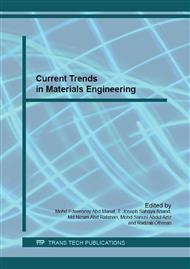p.160
p.167
p.172
p.179
p.184
p.189
p.195
p.203
p.208
The Performance of Lime Sludge Added Bioactive Glass in the Formation of HA Layer
Abstract:
Lime sludge (LS) is a solid waste from lime making industry and normally disposed in landfill or recycled. LS has been studied as one of the raw materials in various ceramic productions such as bricks, ceramic tiles and glass-ceramics. In this study, LS was utilized in the preparation of bioactive glass using the 45S5 bioactive glass. The 45S5 bioactive glass contains SiO2 (45 wt.%), Na2O (24.5 wt.%), CaO (24.5 wt.%) and P2O5 (6 wt.%). It has the ability to bond with soft tissue and promote bone growth. The LS was combined with bioactive glass as a potential replacement of calcium carbonate (CaCO3). The ratio between LS:CaO was varied (0:100, 25:75, 50:50, 75:25 and 100:0) to study the effect of LS weight percentage on the bioctive glass. The preparations of bioactive glasses involved batching, mixing, melting at 1400 °C, water quench and milling. LS was characterized using X-ray diffraction (XRD), while the fabricated glasses were characterized using particle size analyzer, XRD and scanning electron microscopy (SEM). The XRD results proved that the phase and chemical composition of bioactive glass were not affected by the addition of LS. The XRD and SEM results indicated that the addition of lime sludge in bioactive glass was effective to promote the formation of hydroxyapatite (HA) layer.
Info:
Periodical:
Pages:
184-188
Citation:
Online since:
May 2016
Keywords:
Price:
Сopyright:
© 2016 Trans Tech Publications Ltd. All Rights Reserved
Share:
Citation:


